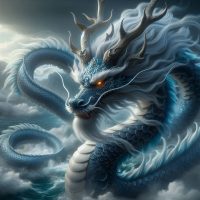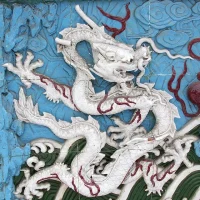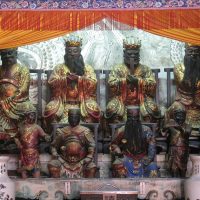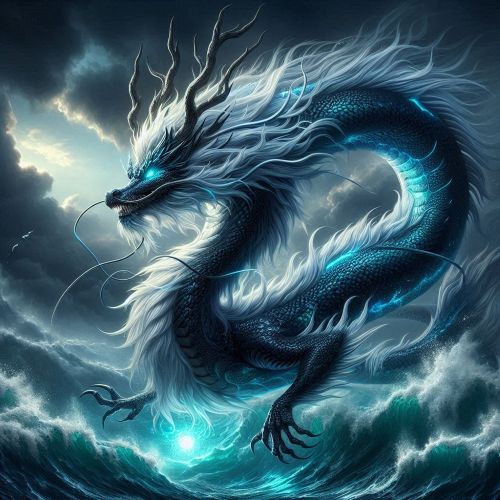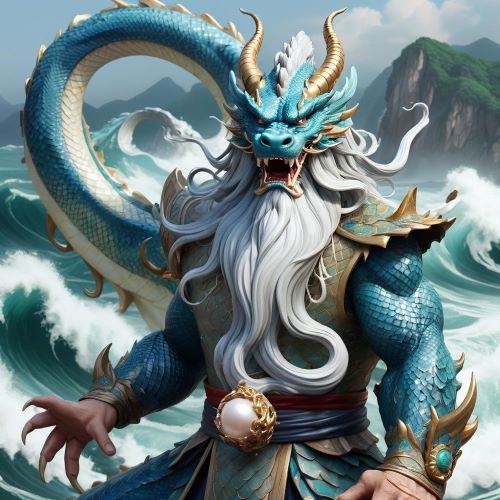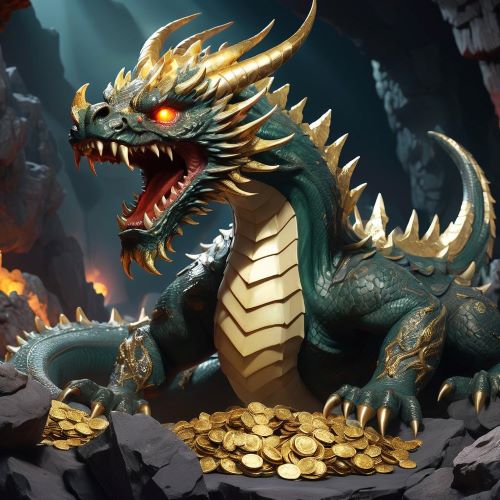Ao Run : Chinese Dragon King of the Western Seas
Listen
At a glance
| Description | |
|---|---|
| Origin | Chinese Mythology |
| Classification | Animals |
| Family Members | Ao Shun, Ao Qin, Ao Guang |
| Region | China |
| Associated With | Western Seas |
Ao Run
Introduction
Ao Run (敖闰), also known as Ao Ji (敖吉) or Ao Jun, is revered in Chinese mythology as the Dragon King of the West Sea. He is one of the legendary Four Dragon Kings (Sihai Longwang) who each preside over one of the cardinal seas encircling China. While Ao Guang rules the East Sea, Ao Qin the South, and Ao Shun the North, Ao Run governs the waters of the West, often identified with Qinghai Lake — China’s largest inland lake. Though Qinghai is not technically an ocean, it represents the vast western expanse of the mythological sea under Ao Run’s dominion. His story embodies the essential Chinese belief that dragons serve as divine custodians of balance, ensuring harmony between heaven, earth, and water. Ao Run’s myth reflects the deep interconnection between natural forces and human prosperity, symbolizing both power and benevolence in the ever-shifting tapestry of Chinese cosmology.
Physical Traits
Ao Run is portrayed as a magnificent dragon embodying both strength and serenity. His elongated, serpentine body shimmers with iridescent scales that glint like waves beneath the sun. Unlike the monstrous dragons of Western mythology, Chinese dragons like Ao Run exude grace and wisdom. His body coils endlessly, his whiskers trail like mist, and his antlered crown radiates divine authority. Some depictions show him with deep blue scales, representing his connection to the western waters and the calm vastness of Qinghai Lake. In contemporary adaptations such as animated films, Ao Run is sometimes rendered with anthropomorphic traits — tall, regal, and commanding — bridging the gap between celestial deity and human-like king. Whether in ancient murals or modern animation, Ao Run’s form evokes a sense of order and majesty that mirrors his dominion over the life-giving element of water.
Family
Ao Run is traditionally the youngest of the four sons born to the Dragon King of Heaven and the Dragon Queen. His elder brothers—Ao Guang of the East, Ao Qin of the South, and Ao Shun of the North—rule the remaining seas, forming a quadrilateral guardianship over the world’s waters. Each sibling reflects a unique personality and domain, yet they act in unity to maintain natural equilibrium. Ao Run himself fathered three children: Yulong (玉龙), the “Jade Dragon” who later becomes the mount of Tang Sanzang in the epic Journey to the West; Ao Moang (敖摩昂), a brave and loyal dragon prince; and Ao Cinxin (敖寸心), known as the Dragon Maiden of the West Sea, a gentle spirit associated with purity and compassion. This lineage reinforces the cyclical continuity of the Dragon Kings’ duties, representing divine stewardship passed across generations.
Other names
In ancient texts and regional traditions, Ao Run is also referred to as Ao Ji or Ao Jun. These variations stem from linguistic differences in dialects and transcription over centuries. Regardless of the name used, they all denote the same mythological being—the Dragon King of the West Sea. His worship spread beyond China’s borders through cultural exchange and maritime trade, influencing neighboring mythologies in Korea and Vietnam, where dragon kings of the four seas also feature prominently. The persistence of his various names across East Asian folklore testifies to the shared reverence for dragons as emblems of prosperity and divine justice.
Powers and Abilities
As one of the Four Dragon Kings, Ao Run commands immense supernatural power over the natural elements, particularly water and weather. He controls rainfall, governs tides, and calms tempests to ensure agricultural fertility and environmental balance. Ancient chronicles describe how Ao Run once discovered that no sea existed in the western lands. To create one, he summoned a mighty storm, calling upon the Lord of Thunder, Mother of Lightning, Earl of Wind, and Youth of Cloud. Together they unleashed their elemental fury, forming the vast expanse of the West Sea, which humans came to associate with Qinghai Lake. This act of creation symbolizes his ability to harness chaos into harmony.
In addition to weather manipulation, Ao Run can transform his shape, soaring into the heavens as a celestial dragon or descending to earth as a mist or river. His immortality is tied to his divine essence, and he can influence the fertility of land and crops. In Taoist rituals, he is invoked during prayers for rain or protection from floods. Legends also attribute to him powers of communication with other deities, serving as an intermediary between the heavens and humanity. Through these gifts, Ao Run exemplifies the delicate balance between wrath and benevolence, destruction and renewal—a dynamic at the heart of all dragon lore.
Modern Day Influence
Ao Run’s mythology continues to thrive in both spiritual practice and popular culture. Temples dedicated to the Four Dragon Kings, including Ao Run, still stand throughout China, especially near lakes and rivers where locals pray for favorable weather and protection against droughts. In these ceremonies, offerings of incense and jade are made to honor his guardianship over the waters. His story endures in Chinese opera, traditional paintings, and festival rituals celebrating the dragon as a divine protector.
In modern media, Ao Run has found renewed life through films, animation, and digital art. The 2019 film Ne Zha and its upcoming sequel Ne Zha 2 (2025) reimagine Ao Run as a powerful yet conflicted figure, blending mythological authenticity with cinematic flair. His portrayal in such works reflects evolving interpretations of mythology, where ancient gods are recast as complex characters with moral depth and emotional nuance. Beyond entertainment, Ao Run also influences educational storytelling about ecology and harmony, symbolizing the importance of respecting nature’s cycles.
In feng shui, dragons remain auspicious symbols of prosperity and protection. Ao Run, associated with the West and the element of water, represents adaptability, wealth, and the continuous flow of life energy. His influence extends to art, video games, and online storytelling, where he often appears as a guardian spirit or sea deity. The persistence of his legend across thousands of years underscores not only his divine power but also his cultural adaptability. Ao Run stands as a bridge between myth and modernity, a timeless emblem of nature’s grandeur and the human longing to live in harmony with it.
Related Images
Source
Wikipedia contributors. (2007, January 29). Ao Run. In Wikipedia. Retrieved November 4, 2025, from https://en.wikipedia.org/wiki/Ao_Run
Wikipedia contributors. (2025, April 10). Dragon King. In Wikipedia. Retrieved November 4, 2025, from https://en.wikipedia.org/wiki/Dragon_King
Nataliasuri. (2024, November 14). The Legend of the Four Dragon Kings: Guardians of China’s Rivers. Retrieved November 4, 2025, from https://www.nataliasuri.com/the-legend-of-the-four-dragon-kings-guardians-of-chinas-rivers/
Godchecker. (2018, September 25). AO RUN – Chinese Mythology. Retrieved November 4, 2025, from https://www.godchecker.com/chinese-mythology/AO-RUN/
Public Domain Super Heroes Wiki. (2024, October 28). Ao Run. Retrieved November 4, 2025, from https://pdsh.fandom.com/wiki/Ao_Run
Creel, H. G. (Year unknown). Chinese Religious Beliefs and Symbolism [Book]. (Referencing broader dragon and deity symbolism in Chinese tradition).
Allan, S. (1991). The Shape of the Turtle: Myth, Art, and Cosmos in Early China. SUNY Press.
Yang, L. (2005). Handbook of Chinese Mythology. Oxford University Press.
Birrell, A. (1993). Chinese Mythology: An Introduction. Johns Hopkins University Press.
Wu, K. C. (1982). The Chinese Heritage. Crown Publishers.
Lagerwey, J. (2010). China: A Religious State. University of Hong Kong Press.
Teiser, S. F. (1999). The Ghost Festival in Medieval China. Princeton University Press.
Frequently Asked Questions
Who is Ao Run in Chinese mythology?
Ao Run is the Dragon King of the Western Sea, one of the four Dragon Kings who govern the world’s oceans in Chinese mythology.
What does Ao Run symbolize?
He represents the West, autumn, and the natural forces of shifting tides and changing weather.
How is Ao Run related to other Dragon Kings?
He is one of the four Dragon King brothers, alongside Ao Guang of the East, Ao Qin of the South, and Ao Shun of the North.
Where does Ao Run rule?
His domain is the Western Sea, often linked to regions beyond China’s western borders and the open waters of ancient maritime trade routes.
Does Ao Run appear in popular stories?
Yes, Ao Run is featured in various folk legends and occasionally in retellings of journey-style epics involving the Dragon Palace and the rulers of the seas.


